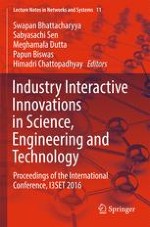The book is a collection of peer-reviewed scientific papers submitted by active researchers in the International Conference on Industry Interactive Innovation in Science, Engineering and Technology (I3SET 2016). The conference is a collective initiative of all departments and disciplines of JIS College of Engineering (an autonomous institution), Kalyani, West Bengal, India. The primary objective of the conference is to strengthen interdisciplinary research and encourage innovation in a demand-driven way as desired by the industry for escalating technology for mankind.
A galaxy of academicians, professionals, scientists, industry people and researchers from different parts of the country and abroad shared and contributed their knowledge. The major areas of I3SET 2016 include nonconventional energy and advanced power systems; nanotechnology and applications; pattern recognition and machine intelligence; digital signal and image processing; modern instrumentation, control, robotics and automation; civil engineering and structural design; real-time and embedded systems, communication and devices; advanced optimization techniques; biotechnology, biomedical instrumentation and bioinformatics; and outcome based education.
